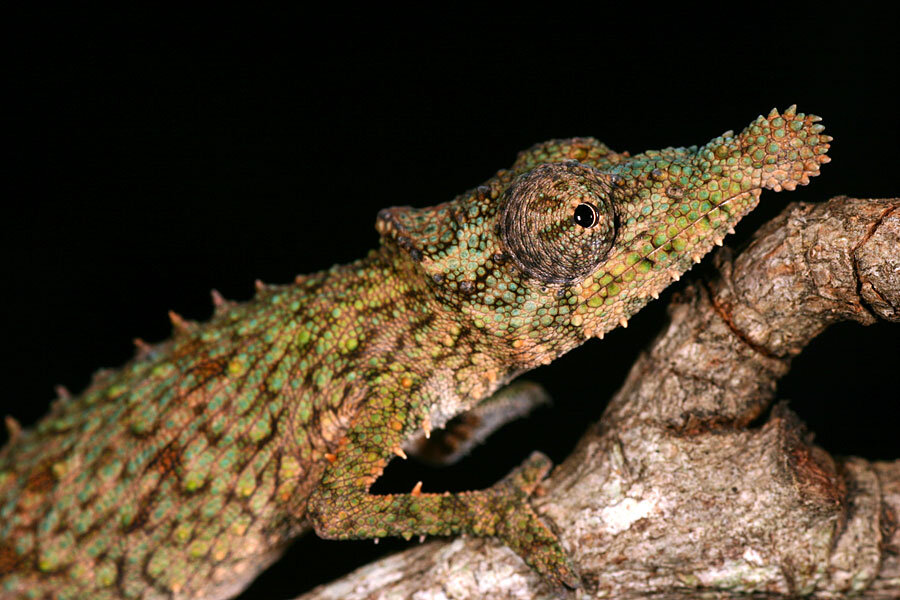The smallest chameleons have the quickest tongues, say scientists
Loading...
Chameleons shoot their long, sticky tongues out at high speeds to snag an unsuspecting snack.
Scientists have long known about the color-changing animals' tricky prey capture. But new research reveals that the tiniest chameleons actually have the most powerful tongues.
Chameleons as small as about 1.5 inches long can shoot their tongues out some 2.5 times their body length to capture a cricket or other tasty morsel, according to a study published Monday in the journal Scientific Reports. That's farther than the previously thought maximum of twice the animal's body length.
That tongue isn't just long. It's speedy, too. The tiny chameleon's tongue can accelerate at a rate of up to 264 times the acceleration of gravity, akin to going from 0 to 60 miles per hour in just a hundredth of a second. But the chameleon doesn't need more than about 20 milliseconds to grab its prey.
That's not all. Researchers also measured the power output of the chameleon tongues, which ranged from 1,410 watts per kilogram up to 14,040 watts per kilogram.
"In fact, the acceleration and the power output we determined to be the highest acceleration and power output for any movement that's been reported among amniotes," four-limbed vertebrates that lay eggs on land or that are carried by the mother as embryos, study author Christopher V. Anderson tells The Christian Science Monitor in an interview.
Scientists have long known about the skillful tongue-lashings that chameleons deal to their prey. But most previous research had focused in on larger chameleon species.
There are actually 203 species of chameleon, Dr. Anderson says, "and a lot of these species are quite small."
"By looking at larger individuals and larger species, we really underestimated the capability of chameleons as a group, as a family," Anderson says.
So Anderson looked at 20 different species across different body sizes in his study. He found the previously recorded maximum distance a chameleon could project its tongue – twice its body length – to be too short. Many of the smaller species could project their tongues beyond that.
The animal that performed the best in Anderson's study was just 1.85 inches long, but could project its tongue 2.5 times that length. (Watch that tiny chameleon, the Rosette-nosed Chameleon, in action here.)
How could such a tiny chameleon perform so well? It comes down to metabolism, Anderson says.
"Smaller animals, for their body size, need to consume a larger amount of food than large animals, just simply because of how metabolism scales with body size," he explains. "So these small species are under a lot of pressure to consume a proportionately larger amount of food."
Because the little animals need to snag more sustenance, their tongue can project proportionately farther than their larger counterparts. Anderson also suspects the tiny chameleons can pick up larger prey proportionate to their bodies too.
An elastic, gymnastic tongue
"The tongue apparatus is a complex mechanism that involves muscle, elastic tissues, and the tongue skeleton," Anderson says.
At rest, the chameleon's tongue is made up of muscle and elastic tissue surrounding a bony skeleton. When the animal spots prey, it will start to stick its tongue out of its mouth.
Then, the muscle contracts around the tongue skeleton, Anderson explains. At the same time, the muscle starts lengthening. That lengthening muscle stretches the elastic tissues. This stores energy much like when a human pulls back the string of a bow in a bow and arrow.
As the tongue muscle lengthens, it slides over the tapered tip of the tongue skeleton, Anderson says. This shoots the tongue muscle out toward the prey, forcing the stretched elastic tissue to recoil. Like the release of an arrow from a bow, the tongue is propelled forward.
And this all happens within milliseconds.
So how did Anderson study such a fast mechanism? He slowed it down.
"These are extremely rapid movements," he says. "In order to quantify the performance, we use high-speed video to film individual feeding events from different chameleons."
Anderson captured the chameleons projecting their tongues at 3,000 frames per second and then watched the films slowed down. This allowed them to look at tiny, quick movements that would have been hard to spot by the naked eye.
"I was just blown away by just how high a performance there is in these guys," Anderson says.







